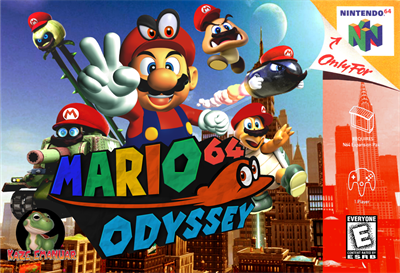


Given the success of Mario 64, Nintendo unsurprisingly followed the same model in the development of Super Mario Sunshine, built around another hub world where players find and unlock new stages. 1-3 and Super Mario World but expands it to an entire game filled with secrets and discoveries. With limitations comes innovation, after all.įans and critics loved Super Mario 64, awed by how it captured the spirit of the more limited exploration available in Mario Bros. The restriction might be the very reason the team invented the sandbox 3D platformer genre. That allowed its developers to reuse assets, which helped them make a full-length game with the limited storage capacity at their disposal.
#Super mario odyssey 64 sixtyforce format series#
In Super Mario 64, instead of playing through a series of levels, Mario undertakes a number of missions across 15 different stages. A Nintendo 64 launch title couldn’t come anywhere close to that number, so the developers improvised. Mario titles on the NES and SNES were stuffed with content. A major limitation was the storage capacity of N64 cartridges, which made the framework of the 2D Mario games next to impossible to adapt to a three-dimensional setting. When it came time to create a Mario game to debut with the Nintendo 64, the team discovered that developing 3D games in the mid-90s came with concessions. Super Mario Bros. created the template for one of the leading genres in that era of video games, which Nintendo further refined in subsequent entries in the series. Third-party publishers noticed the popularity of the genre and developed their own platformers, which resulted in some of video games’ most famous franchises including Mega Man, Castlevania, and Ninja Gaiden, to name just a few. The side-scroller introduced millions of gamers to a new way to play. was one of the earliest platformers to appear on a console, and certainly one of the best. franchise.Ī pack-in title for the Nintendo Entertainment System, Super Mario Bros. , and most famously in the Super Mario Bros. Mario was originally designed within a 2-dimensional framework, starting with Donkey Kong, then Mario Bros. Mario has been a pioneer in movement in video games, which makes sense given that the first Mario titles are platformers, where movement is especially central to the game experience. If you don’t like how a game’s character walks, jumps, or climbs then you’ll find it difficult to enjoy the game as a whole. Movement is key to nearly every video game. Read about how 3D World represents a third branching path for the franchise and Mario’s key role in defining (and redefining) movement in video games. 3D Land and 3D World returned the series to Mario’s roots, bringing classic game design to a three-dimensional setting and in so doing changing once again what it means to be a Mario platformer.


 0 kommentar(er)
0 kommentar(er)
